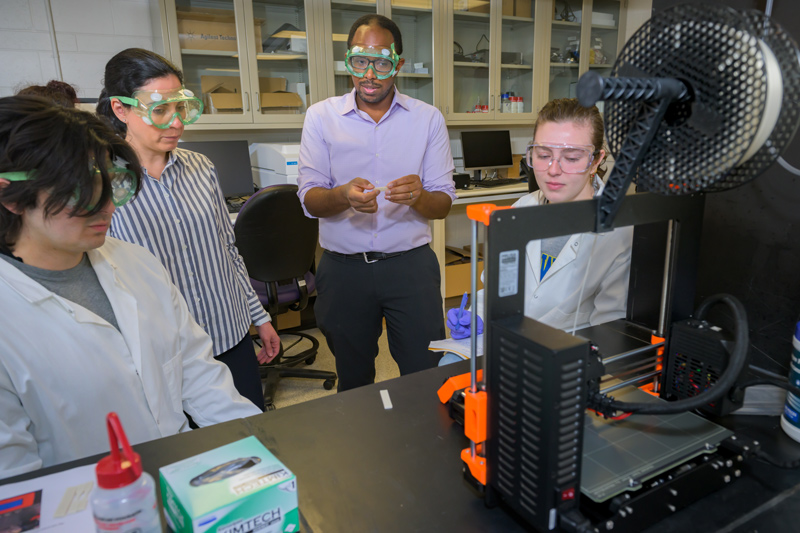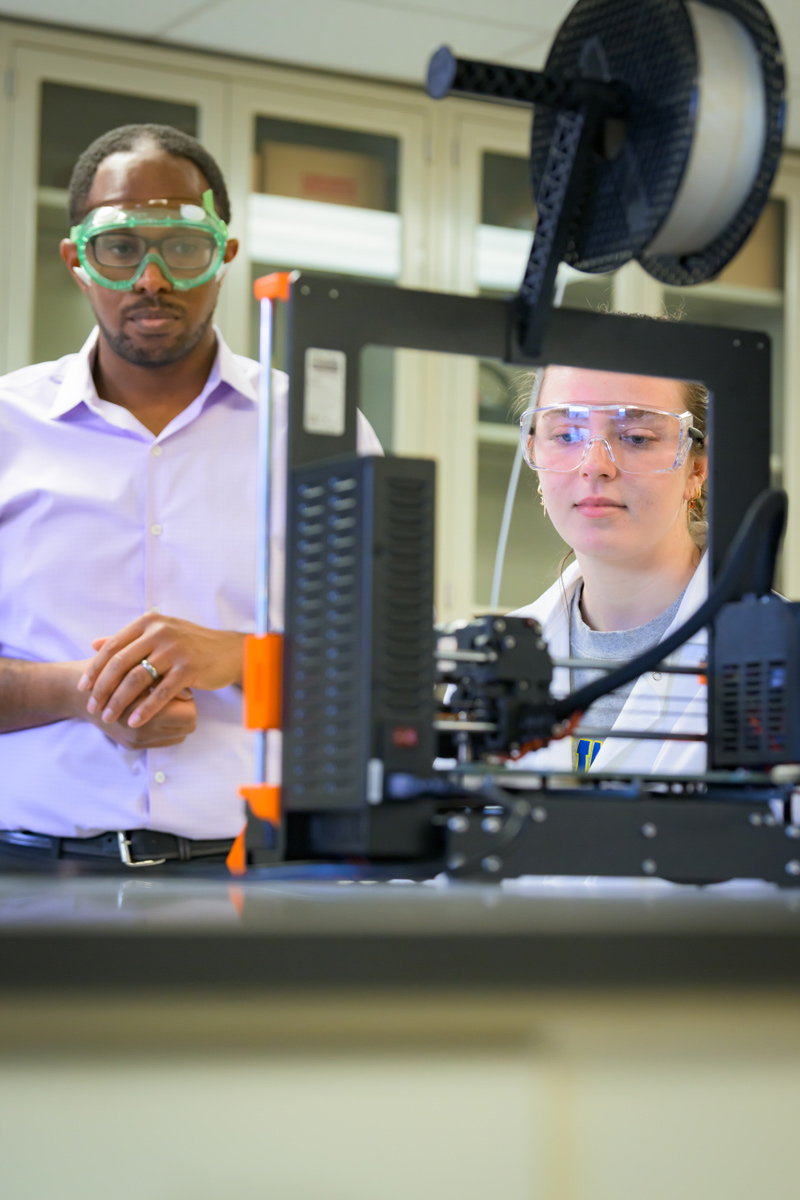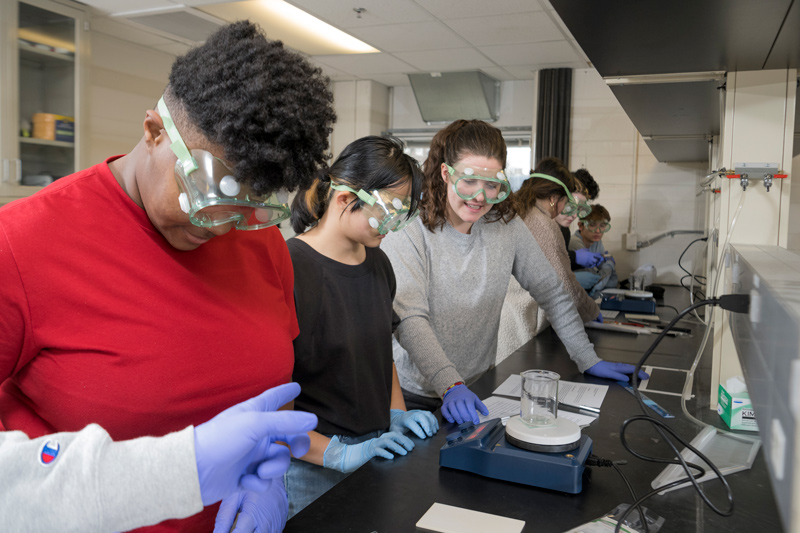


How I Teach — Materials science and engineering
Photos by Kathy F. Atkinson July 13, 2023
In introductory course, Professor Sheldon Hewlett’s students learn about history of materials and gain lab skills
Editor’s note: First-year students, prospective students (and some of their parents) wonder and worry how they will handle the academic transition from high school to college. In a series of stories, UDaily speaks with University of Delaware professors who teach courses commonly taken by students during their first year on campus. The series includes professors who teach biology, writing, business, calculus, political science and sociology, and those stories can be read on the How I Teach website. In this story, Professor Sheldon Hewlett explains his approach to teaching materials science.
Sheldon Hewlett, assistant professor in the University of Delaware’s Department of Materials Science and Engineering, said he believes that anyone can be an engineer. Most people, Hewlett included, don’t wake up in the morning and are naturally gifted in engineering. It takes work, problem-solving skills and passion — and the help, guidance and dedication of professors.
“I do not subscribe to the idea that only certain people can learn engineering,” Hewlett said. “I truly believe that if you want to be an engineer, you can — it's just a question of interest, not of ability.”
As a professor and mentor, it’s Hewlett’s role to set up future engineers for success.
“When students are having trouble, I’ll never say they shouldn't be doing this anymore,” he said. “My job is to figure out how to get you from A to B — how to get you past any roadblocks that are tripping you up. I've never recommended to a student that they shouldn't be in engineering. My job as a professor is to get you to where you need to be.”

For a UD student, the road to being a materials engineer begins in Hewlett’s introductory-level “Freshman Materials Experience” class, where students will learn about the history of materials and scientific developments and gain introductory lab skills.
The first few weeks of the class involve learning about different classes of materials and how they impacted culture and civilization.
“Human history essentially matches that of the materials that we have been using,” Hewlett said. “There's a reason why we call our different eras by the material. We have the stone age, the bronze age, the copper age, the iron age. Right now we're in the digital age, which is really a reflection of the broad semiconductor use right now.”
A typical week consists of two lectures, but a few labs — creating laminated glass, as an example — are woven into the semester so students can get some hands-on experience.
“I could talk forever about materials, but I think it's so much more impactful that they actually get to do something with it,” Hewlett said. “It’s also an opportunity for students to be introduced to topics, equipment and lab activities they might use later on in their college careers, building in soft lab skills but also gauging their interest in materials.”
Materials science is the study of the structure, properties and processing of solid materials. Materials engineers apply the principles of physics, chemistry, biology and mathematics to understanding how atoms are arranged inside materials. From there, they can change material properties and structures to create new, functional materials.
Materials science is applicable in a wide variety of engineering disciplines. A materials engineer could work in the semiconductor industry, pharmaceuticals, biomaterials, personal care products or the automotive industry — to name a few. Most engineering disciplines are going to need some materials engineers to help them choose the right materials and design new materials, Hewlett said. So whether it’s the new iPhone, aircraft or cookware, materials science is at the heart of all aspects of life.
“There's no specific industry for materials science,” Hewlett said. “It’s really wherever there's a need, which is many places.”
While UD’s Department of Materials Science and Engineering is celebrating its 25th anniversary in 2023, the College of Engineering enrolled its first class of undergraduate students into a new undergraduate program in Materials Science and Engineering in the fall of 2019.
The two-credit course serves as an opportunity for students to learn more about what materials scientists do and decide if that’s a major and career they want to pursue. The class has no prerequisites, is intended for newcomers, and is less quantitative than most other engineering courses.
“It sets students up to understand what they'll be doing as material scientists before we get into the nuts and bolts of materials,” Hewlett said. “But it's not super quantitative. Students can expect to have an experience that is maybe a little different than your typical engineering course — it’s a bit more reading- and discussion-focused — but still covers a lot of the same kind of topics.”

Indeed, it’s the history aspect of the course that Hewlett most enjoys teaching because it’s not something he typically covers in more advanced classes.
“It's not something we normally get to do as engineers — dive into the more cultural aspects of engineering,” he said. “But content-wise, that’s a really fun part. I get to bring in all kinds of stories about materials that I think are interesting and fascinating. There are little bits of stories that I get to throw in there that just add color and add interest to the whole picture of materials, and that part is really cool to me.”
The introductory course is not easy, but Hewlett emphasized that there is a difference between rigor and difficulty.
“I think the more rigorous something is doesn't mean that it has to necessarily be the most difficult thing a student has ever worked on,” he said. “I think there are ways we as teachers can make things approachable for students so they can manage how to learn and learn how to learn, but also still are learning the content.”
Hewlett encourages students, especially first-year students, to talk in class.
“If you're the kind of person who's holding back because you're afraid of what other people will think, don't worry about it,” he said. “We don't expect every answer to be perfect. We expect you to try, and we want you to be engaged with the class. One of the things you're developing in an engineering class is learning how to problem solve, and sometimes that process needs to be made vocal.”
Aidan Kypreos, a materials science and engineering major who took Freshman Materials Experience in the spring of 2023, said he enjoyed the class because it was discussion-based and he was able to go to the lab several times throughout the semester.
“I definitely enjoyed the open-ended part of it, where each class could go in a different direction based on what we say and add to the conversation,” Kypreos said. “It's a lot of critical thinking and thinking on your toes to come up with a solution or thinking of a material that maybe doesn't exist yet — but just throwing the idea out there.”
Hewlett takes pride in being out in the world and understanding how materials are made and why they work the way they do — a passion he hopes to pass along to his students.
“You start to see the world in a different view when you actually learn about materials in this way,” Hewlett said. “There's some truth to that for a lot of the engineering fields, but materials, in particular — because it's so tangible — you really get that in spades.”
Support for Academic Success
The University of Delaware empowers all Blue Hens with the skills and strategies they need to succeed.
UD students in any major are encouraged to take advantage of a range of peer tutoring services, as well as comprehensive skill-building resources offered by the Office of Academic Enrichment (OAE). Most services are available free of charge. To learn more, visit the OAE website. Students may also utilize the Blue Hen SUCCESS platform to connect with their academic advisor or access additional resources on Advising Central.
For UD’s community of educators, the Center for Teaching and Assessment of Learning (CTAL) offers programs, workshops and confidential consultations to support faculty as they develop and achieve their pedagogical goals. UD instructors at every stage of their career are invited to explore online and contact ctal-info@udel.edu.
How I Teach — Series
The How I Teach website provides a collection of the stories in this series.
Contact Us
Have a UDaily story idea?
Contact us at ocm@udel.edu
Members of the press
Contact us at 302-831-NEWS or visit the Media Relations website

